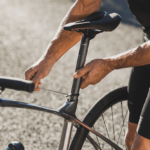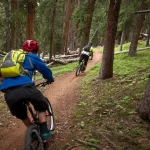Everyone knows that riding a mountain bike on snow is not the same as riding on gravel.
Riding a mountain bike on snow is not easy. If you ride too fast, it will cause your tires to slide out from under you or sink into deep drifts of snow.
But, the main reason you have clicked on our article is to find out whether or not you can actually ride your mountain bike on the snow, isn’t it?
So, as you understand from the title, this article would be about the specific skills needed for mountain biking in the snow. It would also talk about what type of mountain biking gear is needed to go for a ride in the snow.
Are mountain bikes good for snow?
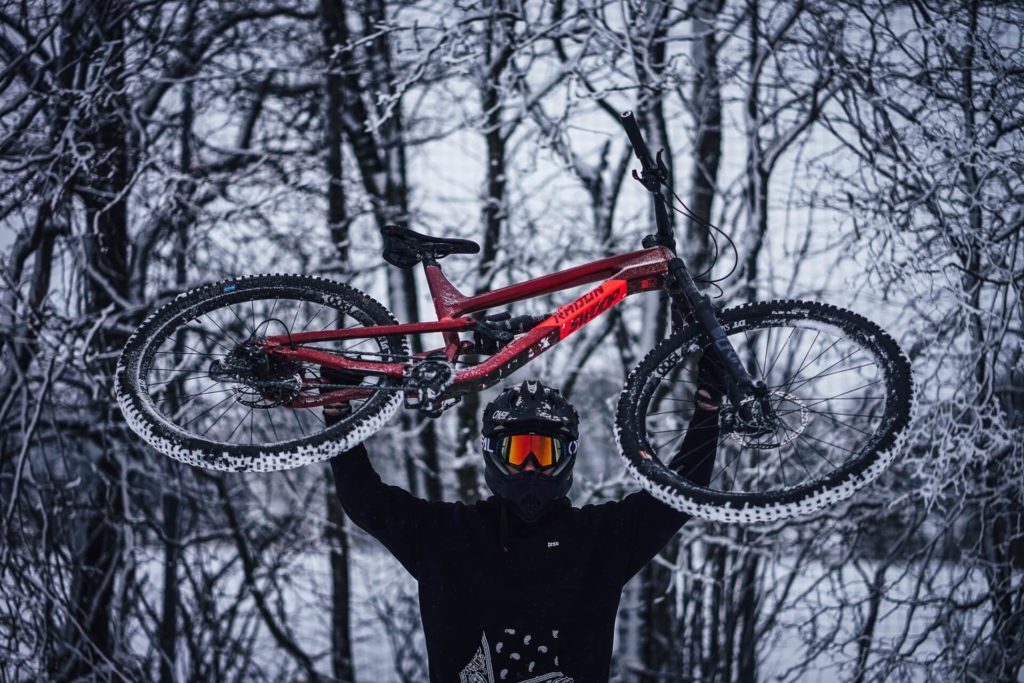
Mountain bikes are not the best choice for snowy or slippery surfaces which makes them a less than ideal choice for winter riding but you can still do that if you want.
As winter approaches, many people get excited about the abundance of snow they get to ride. While others are terrified of the cold and the slippery hills. But there is one thing that everyone agrees on – winter biking is awesome!
Anyone can enjoy the magic of winter biking, but it requires certain equipment in order to be safe. The most important thing to wear is a helmet. This will protect your head from accidents and will also ensure that you don’t lose too much body heat. You should also wear gloves, thick socks or any other protective gear for your hands or lower body.
The second most important thing for mountain biking in winter are mountain bikes with fat tires – this will help you climb steep hills with ease when even walking can be difficult due to ice, snow or sludge.
Snow is not something that mountain bikes were built for so they will not be good at it. Mountain bikes were made to handle paved surfaces and hard-packed trails which is why they may feel less comfortable when ridden on snow or ice-covered ground. The best way to get around the snow is by using a bicycle with wide tires and more suspension (these can provide traction).
Can mountain bikes be used on snow? Let’s find this out
Can you ride a bike in the snow? The answer is not clear because it mainly depends on some things.
It will depend on the stiffness of your bike’s suspension, the air pressure in your tires, the width of your tire tread, and other factors. You can get away with it if you are gentle with the brakes and gears.
In general, many people can say that Mountain bikes are not designed to be used on snow, at least not for an extended period of time because the snow surface is slippery enough for this kind of bike.
The tires are usually built with a tread that is meant to grip the ground through the course of bumpy terrain.
However, below we have good news for you because:
- Mountain bikes are very durable and sturdy, therefore they can be used on snow without a problem. They also have thicker tires.
- The type of gear you need for this is called a fat tire bike, which is made to help cyclists get through any type of terrain or environment that they may come across while riding their bike.
If your mountain bike matches those requirements, then you are okay to ride in the snow.
Is it OK to ride your bike in the snow?
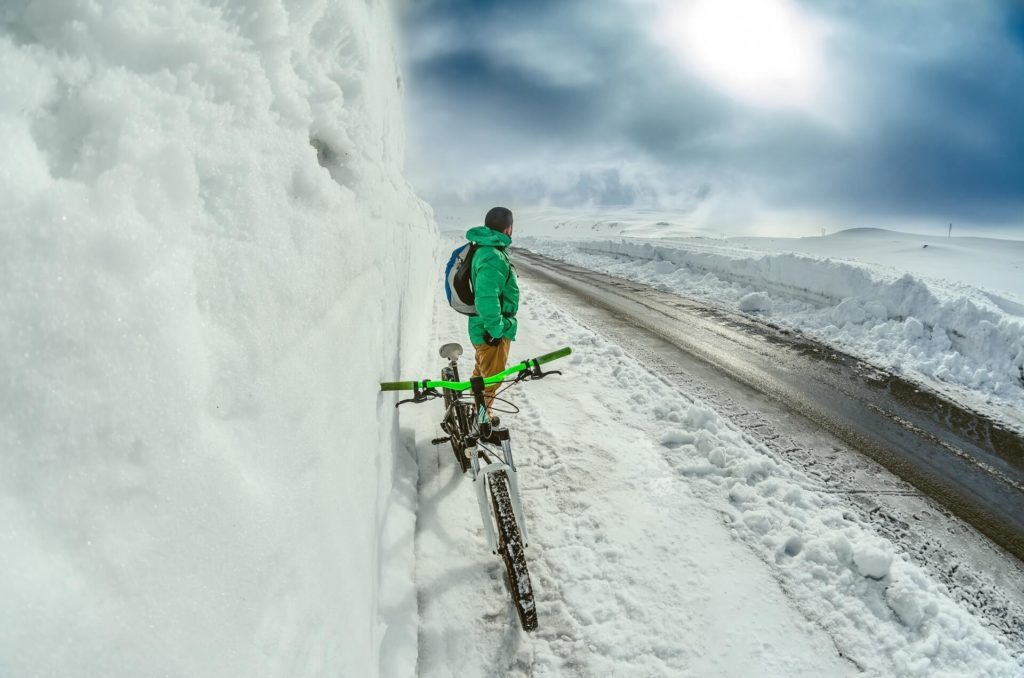
The question of whether or not it is ok to ride a bike in the snow often arises when the winter months come around. If we look at this from a safety perspective, we can see that riding a bike in the snow is actually encouraged for many reasons such as reducing the risk of injury due to increased traction on snowy surfaces and taking advantage
People can ride their bikes in the snow as long as they take the necessary precautions. It is important to pay attention to ice and snow on the road. You may need to remove your kickstand and use your feet to push down on the pedals.
The amount of traction you have is dependent on how much ice, snow, or slush there is. If you are riding up a hill, make sure that you take it slow and be careful about making sharp turns or stopping suddenly which could cause you to lose traction and slide downhill.
I’ll let you in on a little secret: it’s not only ok but encouraged.
Snow is a blessing for two reasons:
- It forces you to slow down and enjoy the scenery; and
- It levels the playing field.
You can go fast without having to worry about tire traction and you don’t need to break your back by lifting your bike over every snowdrift.
Benefits of cycling on the snow
There are a lot of benefits to riding a bike in the snow. It is a great way to maintain your fitness and it will help you clear your head.
The greatest benefit is that you can save on gas money by not driving or relying on public transportation. There are some safety precautions that you should take into consideration before going out in the snow, though.
Riding a bicycle in the snow can be dangerous due to icy conditions and lack of traction on the ground. If you do decide to ride your bike in winter conditions, make sure that you have at least one light set up for visibility and something like studded tires which provide better grip on icy surfaces.
Can you mountain bike in winter?
Mountain biking in winter can be a great way to explore nature in the winter. There are some safety precautions that you should take before heading out on your journey.
Whether you can mountain bike in winter depends on factors such as the state of the trails and the temperature.
We already know that mountain biking in winter is not the same as in spring or summer. There are some factors that are unique to winter mountain biking, which I will go over in this article.
Factors to consider:
– The snow depth and whether it is compacted
– Whether the trail is open
– The temperature, snow conditions, and how much snow there is
Also, there is a nice blog post by the bicycling site that you can check out later about some tips for riding a bike in the winter.
Mountain bike tires tend to be narrower in the winter, which makes them less stable on rough surfaces and they can get stuck easily in snow or ice pits. Winter also means there is more moisture in the air, which makes conditions quite slippery when it’s really cold outside.
What mountain bike is the best for snow?
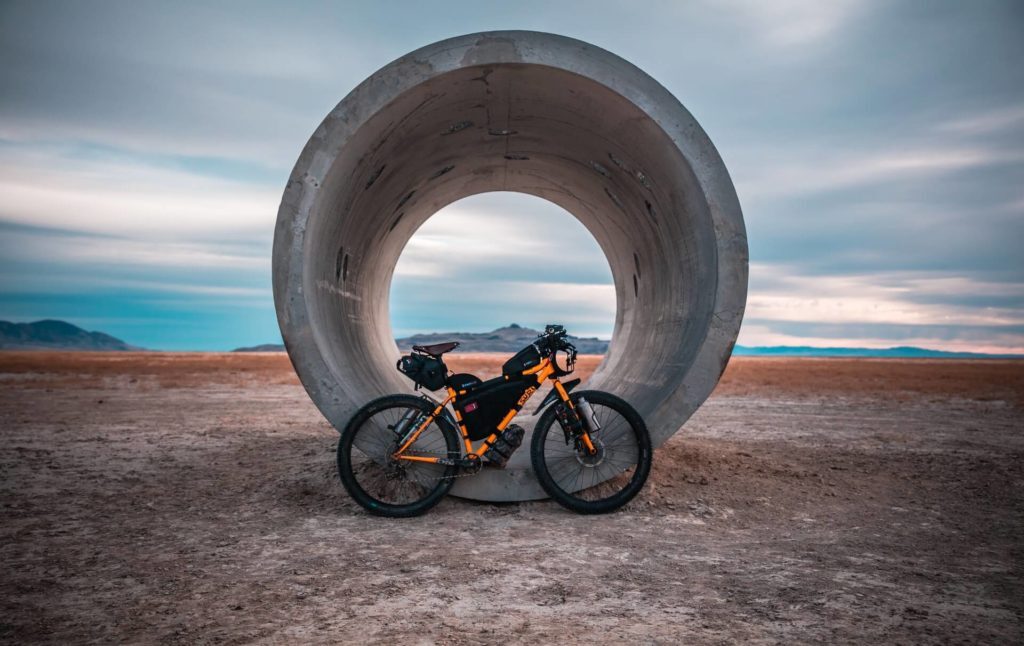
This section discusses the best type of mountain bike for snow conditions.
When looking for the best mountain bike for snow, it is important to consider three things: suspension, weight, and tread.
For this case, we have done a small research in order to find out the ideal and the best Mountain Bike for snow and similar surfaces.
And we have found this Mountain Bike named:
Surly Pugsley
The Surly Pugsley bike was originally created and tested in Minnesota winters. This is a reason to be enough to convince you that Surly Pugsley is a good Mountain Bike for snow and winter.
Known as the first established snow bike, the Pugsley has a strong steel frame and a big-knobbed tire tread which is perfect for snow roads and bad weather conditions.
Features:
- Frame and Fork: 4130 Chromoly steel. Frame’s double-butted tubing in main triangle adds strength
- It has 18 gears
- 26 inches wheels
- Front Hub: Surly Ultra New, 32h
- Rear Hub: Shimano Deore, 32h
- Tires: Surly Nate, 2.6×3.8
- The price of Surly Pugsley is around $1,750
We know that the price of it may be too high for many people but in our recent blog post, we explained why mountain bikes are so expensive these days. You can check it out later if you want.
What temperature is too cold for mountain biking?
The answer to the question “what temperature is too cold for mountain biking?” varies across the world because Mountain biking can be done all the seasons of the year.
If you’re thinking about mountain biking in the cold, here’s what you need to know:
Mountain biking is most enjoyable when the weather is not too hot and not too cold.
Also, before we move to the numbers, you have to consider for example that the climate of Australia is way more different than the climate of Norway, so the impact of temperature is different from country to country.
The best temperature for mountain biking on average is about 50 degrees Fahrenheit (10 degrees Celsius).
In general, temperatures below 50 F (10 C) may be too cold for those who are not used to such weather and those who do not have appropriate clothing. The lower limit of 50 F (10 C) will depend on your specific body and situation factors and should not be considered a hard and fast rule.
When we say “too cold” we mean below this temperature. So, if it is 20 degrees F (-7 degrees C), that would be a good time to call it quits after an hour or two.
How deep of snow can you ride a fat bike in?
Honestly speaking, nobody can answer this question with .100%.
A fat bike is a bike that has a wide, low-pressure tire with a tread on the outer edge. This design provides tons of traction so you can ride on surfaces that are too difficult for regular bikes. That being said, it depends on how deep of snow you have and how steep the slope is.
This is a question that many people have been asking themselves. I have been conducting research to find the answer to this question, and hopefully provide some insights into the usefulness of a fat bike as a winter commuter.
In order for us to determine how deep of snow you can ride a fat bike in, we first had to define what “ride” means.
For the purposes of this article, riding a fat bike in deep snow is going for a distance equal or greater than one through five miles with an average grade of less than 8%.
Conclusion
All in all, Mountain Biking is great in all weather conditions because every season has its magic and uniqueness. Can Mountain bikes be used on snow? Yes, for sure! but you have to be careful of what we mentioned before. Also, take care of your equipment and wear enough clothes because a cold riding in the winter needs the right preparation!




